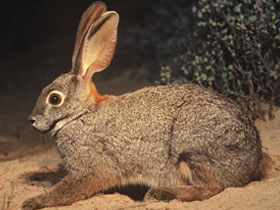The riverine rabbit (Bunolagus monticularis), bushman rabbit or bushman hare
The riverine rabbit (Bunolagus monticularis), also known as the bushman rabbit or bushman hare, is a rabbit with an extremely limited distribution area, found only in the central and southern regions of the Karoo Desert of South Africa's Northern Cape Province. It is the only member of the genus Bunolagus because of unique traits that separate it from the other leporids. It is one of the most endangered mammals in the world, with only around 500 living adults, and 1500 overall.
Distribution
Bunolagus monticularis is a rare species of hare-like creature, allocated to the monotypic genus Bunolagus. It inhabits the Karru Desert in the Cape Province of the Republic of South Africa. Numbers in natural populations are less than 500 sexually mature individuals.
Appearance
The dense, silky fur of Bunolagus monticularis is grey above, reddish on the sides and white below. It has a red spot on the back of the head. The ears are very long. The tail is fluffy brown. The male hare weighs approximately 1.5kg, while the female weighs about 1.8kg. The body length ranges from 33 to 47 cm.
Lifestyle and diet
Bunolagus monticularis feeds on leaves, bark, twigs and flowers, like other hares, it is characterised by coprophagy. It is more active and feeds more frequently at night.
Taxonomy
The riverine rabbit's scientific name is Bunolagus monticularis. Some common names referring to it are the bushman hare and the bushman rabbit. This rabbit also has less common names such as boshaas and vleihaas. These names arose from the habitats they lived in and are based on how these were moist and dense. Genetically, its closest relations are to the Amami rabbit, the Hispid hare, and the European rabbit.
Diet
The riverine rabbit is predominantly known for being a “browser”. They eat riparian vegetation found along seasonal rivers in the Karoo Desert. This includes salt-loving plants such as the salsola and lycium. They sometimes eat grass depending on if it is the wet season. Aside from their conventional food intake, they also consume their day-time droppings which are soft and come directly from the anus. This is advantageous because their faeces contains vitamin produced by the bacteria in the hindgut and also contains minerals such as calcium and phosphorus.
Behaviour
Riverine rabbits are solitary and nocturnal. They feed on their preferred foods, flowers, grasses, leaves at night. During the day they rest in forms. It produces two types of droppings. While active during the night the rabbit will produce hard droppings, and during the day droppings are soft, taken directly from the anus, and swallowed. In this way the riverine rabbit obtains vitamin B, produced by bacteria in the hind gut, and minerals such as calcium and phosphorus are recycled.
They are polygamous, but they live and browse for food alone. They have intra-sexually exclusive home ranges; the males' home ranges overlap slightly with those of the various females. Between August and May, females will make a nest in a burrow lined with grass and fur, and blocked with soil and twigs. This nest is 10–15 cm in diameter, 25 cm long.
Endangerment (extent)
The riverine rabbit is a species that is in extreme danger of extinction. In 1981 it was first labelled as an endangered species. According to the IUCN Red List It is now classified under the most severe category of endangerment (aside from extinction), which is critically endangered. It has a population of only about 500 mature rabbits and 1500 overall which both continue to decline. In addition, the IUCN Red List predicts increased population reduction, in the immediate future. Their exact prediction is for one tenth of the population to be lost between 2002 and 2022. Another problem that this species faces in terms of population is how their already immensely small population is divided into several isolated groups, about 10 in total, all with less than 50 rabbits in each.

















































